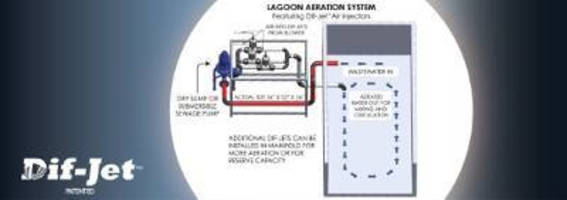Inexpensive Method to Eliminate Odor from Animal Waste Lagoons

WENDELL, N.C. — Odor problems at swine production farms is an old and persistent problem that effect surrounding areas. Some argue that there are health hazards, pollution problems and quality of life issues in the affected areas. Some states have imposed moratoriums limiting the growth of the farmers.
Lagoon Aeration System
The basic problem for the contract or independent farmer is that the farmers really do not have a good method to add dissolved oxygen to the wastewater in the lagoons.
A good way to eliminate lagoon odor is to aerate the lagoon and increase and maintain the amount of dissolved oxygen in the waste lagoons to 2 to 5 mg/L. This will give the beneficial bacteria enough oxygen to live and digest the waste in lieu of just going septic which is the cause of the odor problems.
Using pump aerators that spray the waste water into the air are not very efficient and incur high energy costs. This technology only provides aeration within the spray circle about 18" deep. The deeper areas get very little dissolved oxygen. A normal waste lagoon or series of lagoons may require 5 to 10 spray aerators which can require a total 150 to 300 HP to operate the pumps, generally; the farmers cannot afford the energy costs to run these machines. Maintenance of these units is expensive and time consuming. In addition, this method has no capacity to circulate the aerated water for enhanced bacterial digestion.
Some experts suggest that the industry install anaerobic lagoons to capture and recycle the methane gas the lagoons create. This is very expensive and requires maintenance to ensure the integrity of the lagoon seals. In addition, there may be a safety hazard by storing 3 or 4,000 cubic feet of explosive gas on the farm. The problem is finding a buyer for the gas. The gas would cost more than natural gas due to the transportation and handling involved. The farm operators may not be eager to deal with the safety issues that arise in handling a highly explosive gas.
Most municipalities use aeration for efficient bacterial digestion and modern wastewater treatment plants have no odor problems to speak of. These plants use bottom mounted diffusers in the oxidation ditches or basins to bubble air into the water to provide adequate oxygen for bacterial respiration and good digestion of the organic waste. The issue for the farmer is the cost to install and maintain bottom mounted diffusers as they would quickly foul and become inefficient due to the high solids waste being treated.
Fortrans Inc. offers a good solution for providing cost effective aeration in animal waste lagoons by using the patented Dif-jet air injector that does not foul during operation in high solids water. The Dif-Jet systems are located out of the water so any maintenance is easy.
Each Dif-Jet in the system manifold can add 2.7 to 3 pounds of dissolved oxygen per hour per horsepower to high solids wastewater.
The Dif-Jet air injector system requires a low pressure blower usually 8 to 10 psi. and a heavy duty sewage pump to power the aeration manifold and circulate the aerated water.
The entire lagoon would have the desired amount of dissolved oxygen in the water. The total HP required would be around 45 to 80 depending on capacity of the lagoon.
The systems cost around $100,000 to $250,000 depending on the size of the blower and pump required to maintain the level of dissolved oxygen for the capacity of the lagoon. See our website for more information: http://www.fortransaeration.com.
This system is affordable and works better than other products and designs offered to the industry. An additional benefit to the community is odor reduction when the sludge is land applied.
Media Contact:
Robert C. Cooke, Pres.
Fortrans Inc.
919-365-8004




